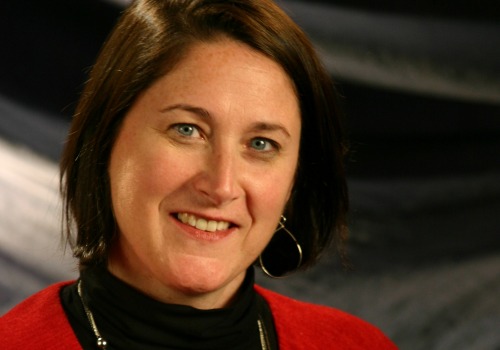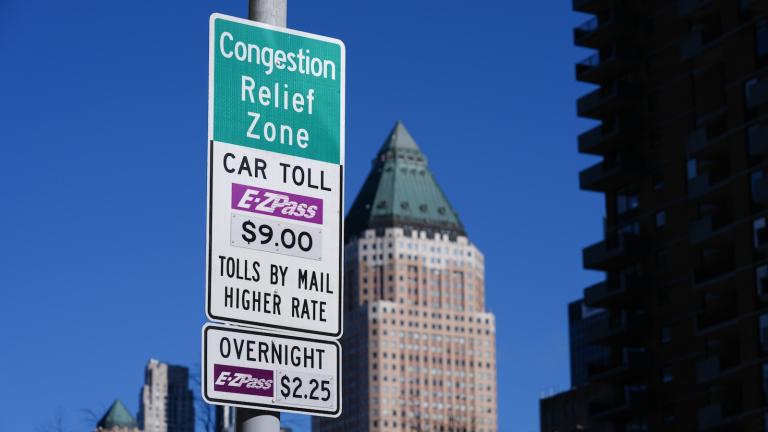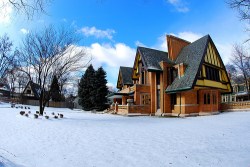
clarkmaxwellFrank Lloyd Wright lived and worked in Oak Park.
The village of Oak Park might seem indistinguishable from its neighbors. A suburb on the western edge of Chicago, it shares a street grid with the city and a sustainability plan with a bordering village, River Forest. But this community of 50,000 people has a historic character all its own — and is the hometown of an impressive range of talent, including Homer Simpson voice actor Dan Castellaneta, Ernest Hemingway, actress Betty White, political advisor David Axelrod, and journalist Tavi Gevinson.
Last year, Oak Park bundled its residential electricity accounts and went out to bid for a new energy supplier. Not only did it end up with a more favorable rate, but the deal included 100 percent renewable energy credits, adding 170 million kilowatt-hours of wind power into the regional grid.
And now, the village has volunteered to be a testing ground for “smart grid” technology that could someday revolutionize the way we generate, transmit, and use electricity. And we’re not talking about just smart meters here — rather, a thoroughly digitized, completely transformed system that is tied into a network of renewable sources like wind and solar, and is capable of “self-healing” during storms and outages.
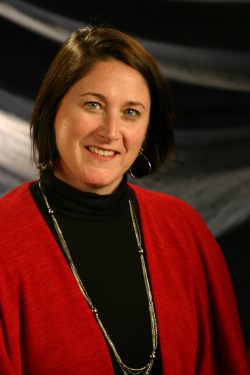
K.C. Poulos.
“Literally every piece of equipment along the way changes,” says Oak Park’s sustainability manager, K.C. Poulos.
The project, which will include a network of small solar-electric systems on residential roofs, is projected to cost between $5 and 6 million, and half of the cost will be covered by the Korea Smart Grid Institute. Oak Park is working with the International Institute for Sustainable Design to secure funding for the rest.
I talked to Poulos for Knope and change, our series about the women behind green changes in our city governments. Here’s an edited version of our conversation about their smart grid experiment. Hat tip to Oak Parker Doug Burke for the suggestion.
Q. Why are you working with the Korea Smart Grid Institute?
A. They did the demonstration on an island in South Korea called Jeju Island. It’s kind of like their Hawaii — it’s a resort area. They were able to put up a demonstration that showed how distributed generation like solar can be connected to a network operations center. All of these houses got battery storage so when you weren’t using your solar power in the house, you could store it in a battery system. When the grid on that island became overloaded with demand, the network operating system could send messages to those households saying, “You need to use to your battery. We’re going to take all of the energy from your solar panels for the next four hours and put them right on the grid. And then we will send you a check next month. Thank you very much for letting us buy your power for four hours.”
Q. You might not even know your house is making you money?
A. Correct, but the system network operating has the ability to send messages to those houses. So you could get a text message on your phone.
Q. For the Oak Park demonstration, do residents have to pay to install the solar panels and smart grid systems?
A. There’s going to be no out-of-pocket expenses for the homeowner. In return, they are agreeing to have the system put in place, to have workers come and work on their houses, and to also give up their energy information to the operating center and to the people running it so we can study how you use your energy given this new system.
Q. What will you be studying?
A. Minute to minute, this system will be collecting data on which of the 200 houses are using what kind of energy. We’re less concerned with, “Oh so-and-so uses her hair dryer from 7:15 to 8.” [Eds. note: So-and-so is either all of Twisted Sister or needs a new hair dryer.] It’s more a matter of what’s the pattern of peak usage; how is the house reacting to different weather conditions; and is the home owner changing his or her behavior?
Q. This is a Glenn Beckian nightmare. Agenda 21! Chicago political machines! How does it feel to be taken over by a foreign entity?
A. This is a collaboration. It’s not the government itself of South Korea that’s working on this — it’s their research institute and their smart grid companies. Their business mission is to create a business model that would allow for the sale of their products. It’s less about Big Brother “we’re going to watch you use your energy” and more about “Hey, what can we sell you?” It’s very consumer-oriented.
Q. Have you gotten much backlash?
A. No. I’ve received hundreds of phone calls from residents who want to join. Keep in mind we’re still finalizing the project. It will be interesting to see what kinds of questions and concerns come up around that very topic of data privacy. That’s a valid issue.
Q. How will the solar and battery energy interact with the grid?
A. There are a couple scenarios a homeowner can choose in terms of how to use it. The one that we talk about the most is this idea of collecting the solar energy during the day and storing it in the battery and then having the house run on the battery at night so you’re completely offline at night and the battery provides a phantom load — your clocks, TV. Your energy load is pretty low at night but that means you’re not taking anything off the grid. So you’re reducing your bill right there.
Then let’s say there’s an outage in your neighborhood. What we want these systems to be able to do is operate off the battery so these houses can stay somewhat energized. It’s only a three kilowatt system on the house so it’s not like you could have every appliance running at the same time. You’ll have enough for lights, fans, and the refrigerator or A/C. But at least you’re online still and you’re not losing an entire freezer of meat.
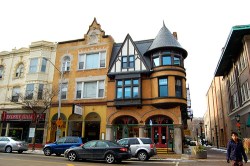
Eric Allix RogersDowntown Oak Park.
Q. How often does Oak Park experience outages?
A. The way the utility provides that number is by average number of minutes out per year per capita. The number for Oak Park is 45 minutes per year. What the number doesn’t tell you about is the stories I hear when [residents] call up on day three of still not having power. Then I get calls from restaurants. You’re talking about an entire week’s or month’s inventory gone.
Q. With climate change, that’s bound to get worse as days and nights heat up and stronger storms knock out lines.
A. This is about climate adaptation too — we’re not just looking at consumer benefits. You want the most resilient local grid system you can get. As temperatures rise, the accumulative effects just keep getting worse and worse. It’s not going to wait for us to make up our minds about whether or not we want to update this stuff. It’s going to keep on coming and we are going to be left holding the bag if we don’t have a system that’s redundant, self-healing, and [monitorable].
Q. Why hasn’t aging electrical infrastructure become a national issue?
A. It’s a sleeper priority that flares up in citizen awareness when something goes wrong. For example, Hurricane Sandy: You’re still hearing about sections of Long Island that are not receiving reliable power. Long Island suffered for days and days and days and there are some irate residents out there. But as the power is restored and you get back to your normal life, it goes into the back of your mind again until the next emergency hits. We can’t live like that.
For me, from a national perspective, we need an energy policy that prioritizes infrastructure rehabilitation and reinvestment. Smart grid investment and infrastructure have the potential to provide even more savings and even more efficiency for business owners and residents beyond what you can do in your own building in terms of smart appliances and energy management and putting renewable energy on the building. Having a whole smart grid infrastructure is just like what we went through in terms of changing from landlines to cell phones. Think of all the things we do now with our phones that were not even conceivable in the 1970s.
Q. Why should the average American should care about this stuff?
A. Do I go for the emotional argument? It’s about the children.
Q. It’s always about the children.
A. You want your house to work as smart as your phone works. You want it be intuitive and you want it to be clean energy that’s coming through. We are creating that possibility.

